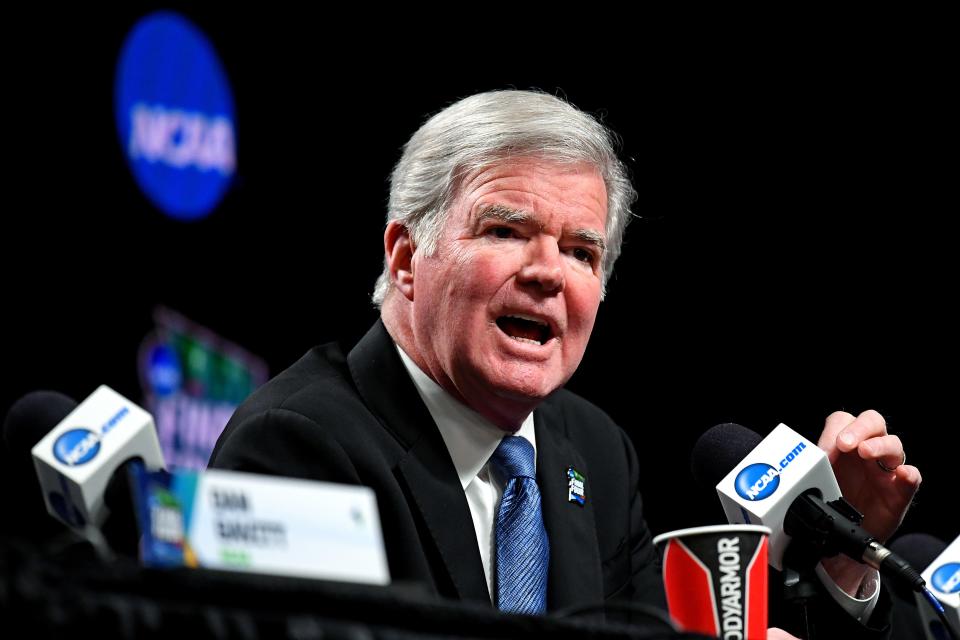Mark Emmert was a failed NCAA president. But removing him won't solve college sports' problems alone | Opinion
All across college athletics Tuesday night, administrators sent each other emojis of champagne glasses and party hats. They prepared their anonymous quotes to text reporters, as if there was something new or interesting to say about the end of Mark Emmert’s failed tenure as NCAA president. Some of them were so happy just to be rid of the guy, they preferred to save their cynicism for another day.
The abrupt announcement that Emmert will be stepping down at some point in the next 14 months was a long time coming. If the measure of a leader is whether their organization is better or worse for their tenure, there is no real debate about Emmert’s legacy: Over nearly a dozen years in office, the NCAA’s standing on almost every issue critical to its existence has diminished.
This wasn’t the result of bad luck, or even necessarily the clunky constraints of the NCAA’s big tent, college president-driven structure. Whether it was name, image and likeness to rules enforcement to gender equity to transfers to negotiating television contracts to forming a legal strategy in cases that could be considered existential threats to the organization, the NCAA under Emmert was reactive rather than proactive, lacked the vision to anticipate big changes and settled for small-bore solutions to paper over foundational problems.
As a result, Emmert leaves behind a job that few qualified people will want and an NCAA that has lost credibility with its own members, with Congress and with a general public that justifiably wonders what purpose it serves other than running a nice basketball tournament.
Whatever strengths or weaknesses he brought to the job, and whatever his personal feelings were about the multitude of challenges the NCAA faced, hardly anyone in college sports would argue that Emmert was successful in navigating them. If he were, Emmert would not have been pushed out Tuesday by the same presidents who gave him a contract extension just a year ago.
At the same time, Emmert’s removal on its own will not be the event that turns the battleship around. In this time of uncertainty and upheaval, what happens next will tell us everything we need to know about where the presidents intend to take college sports.
The tendency in recent times has been to give the job to one of their own. That makes sense when you view the job as a highly-paid piñata for college presidents who are far more concerned about how profitable their medical school is or where they stand in the academic rankings. That’s why some of the immediate speculation centered on college presidents with credibility in the sports realm — someone like Washington State’s Kirk Schulz, who previously chaired the NCAA Board of Governors, or Baylor’s Linda Livingstone, a former college basketball player who served on the Division 1 Board of Directors and the Board of Governors.

But if that’s what the NCAA members want out of their president — another Emmert who has better leadership skills and public relations savvy — it’s hard to see much of a future for the organization after Congress and the courts get done dismantling amateurism.
This might be a time to hand the reins to someone from outside college sports to come in with a more forward-thinking and realistic look at what needs to be done to keep the NCAA relevant and give that person the power to make it happen.
The NCAA needs someone who can credibly navigate Washington, D.C., as it became clear over the past couple years that Senators and Congress members were using Emmert as a punching bag for political points and were not going to actually pass legislation that bailed the NCAA out of its own mess.
It needs someone that can regain the trust of its members, and especially conference commissioners like the SEC’s Greg Sankey and the Big Ten’s Kevin Warren who wield the power to walk away from the NCAA tomorrow if it’s not nimble enough to meet their needs.
It needs someone whose answer to everything isn’t forming another committee. It needs someone who can present a vision for why the NCAA is integral to the management of college sports and betterment of athlete welfare in the modern world, rather than preserving an outdated concept of amateurism that exists nowhere else in sports.
That won’t be an easy job for anyone. The NCAA’s problems are so ingrained and wide-ranging, even the most visionary thinker and powerful personality will face an uphill battle marshaling agendas and building consensus on the future. At least it’ll pay well.
Emmert wasn’t the only problem with college sports, but for more than a decade, he didn’t offer much in the solutions department. At every touchstone moment of his tenure — the Penn State/Jerry Sandusky scandal, the Ed O’Bannon lawsuit that challenged the NCAA’s ownership of likeness rights, the FBI investigation into college basketball, getting routed in the Supreme Court in NCAA v. Alston and more — Emmert was the face of failed strategy and even worse execution.
At the campus level, his departure will be celebrated over the coming days and weeks. But unless the NCAA is ready to reimagine the entire job, including its limitations on power and what direction college presidents want to take the whole organization, the next person in line won’t have much more success than Emmert did.
Follow USA TODAY Sports columnist Dan Wolken on Twitter @DanWolken
This article originally appeared on USA TODAY: Mark Emmert failed, but removing him won't solve all NCAA's problems

